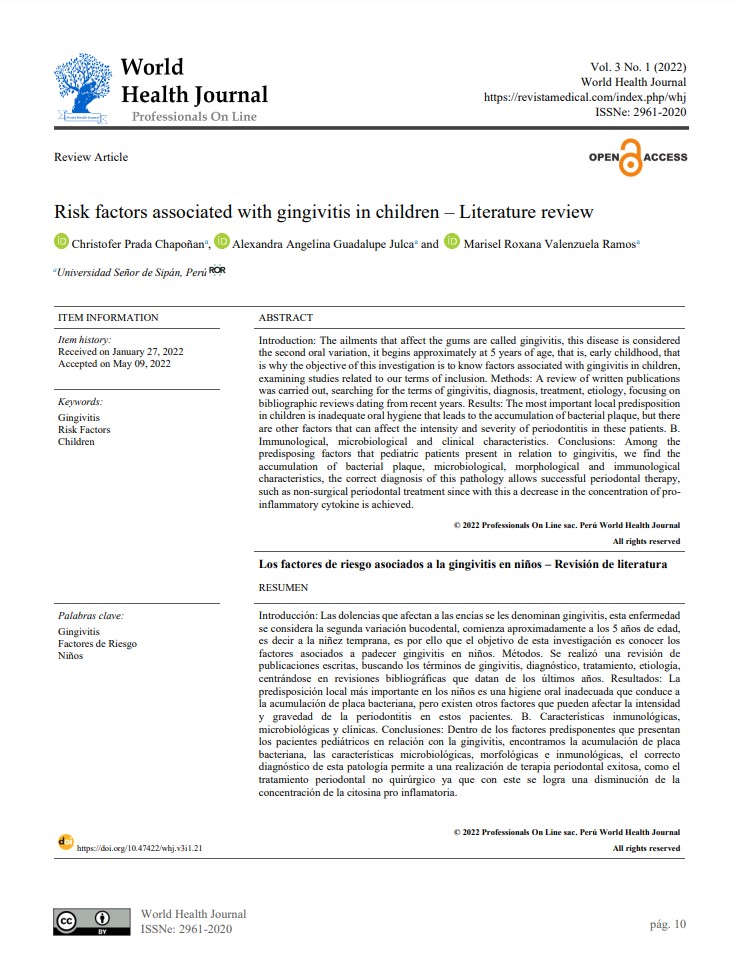Abstract
Introduction: The ailments that affect the gums are called gingivitis, this disease is considered the second oral variation, it begins approximately at 5 years of age, that is, early childhood, that is why the objective of this investigation is to know factors associated with gingivitis in children, examining studies related to our terms of inclusion. Methods: A review of written publications was carried out, searching for the terms of gingivitis, diagnosis, treatment, etiology, focusing on bibliographic reviews dating from recent years. Results: The most important local predisposition in children is inadequate oral hygiene that leads to the accumulation of bacterial plaque, but there are other factors that can affect the intensity and severity of periodontitis in these patients. B. Immunological, microbiological and clinical characteristics. Conclusions: Among the predisposing factors that pediatric patients present in relation to gingivitis, we find the accumulation of bacterial plaque, microbiological, morphological and immunological characteristics, the correct diagnosis of this pathology allows successful periodontal therapy, such as non-surgical periodontal treatment since with this a decrease in the concentration of pro-inflammatory cytokine is achieved.
References
Horner AJ, Nativio DG. Unique factors affecting the management and prevention of caries in the childhood cancer survivor. J Pediatr Health Care [Internet]. 2019;33(1):53–7. Disponible en: https://www.sciencedirect.com/science/article/pii/S0891524518300191
Bussenius H, Reznik D, Moore C. Building a culture of oral health care. J Nurse Pract [Internet]. 2017;13(9):623–7. Disponible en: https://www.sciencedirect.com/science/article/pii/S1555415517306384
Chapple ILC, Mealey BL, Van Dyke TE, Bartold PM, Dommisch H, Eickholz P, et al. Periodontal health and gingival diseases and conditions on an intact and a reduced periodontium: Consensus report of workgroup 1 of the 2017 World Workshop on the Classification of Periodontal and Peri‐Implant Diseases and Conditions. Journal of Clinical Periodontology [Internet]. 2018 Jun 3 [cited 2022 Jul 4];45:S68–77. Available from: https://search.ebscohost.com/login.aspx?direct=true&db=a9h&AN=130287505&lang=es&site=ehost-live
Gingivitis y periodontitis: qué son y por qué la salud de las encías es clave para prevenir enfermedades. Clarin 2022 May 12. Disponible en: https://www.proquest.com/docview/2663916667/3B28FE6758F14B7DPQ/2?accountid=39560
Macín-Cabrera S, Sanz-Alonso M, Castrillón-Rivera L, Palma-Ramos A, Noguez-Méndez N, Quirino-Barreda C, et al. Tratamiento periodontal no quirúrgico en pacientes con gingivitis y periodontitis moderada. Respuesta bioquímica y microbiológica. Rev odontol mex [Internet]. 2015;19(3):155–64. Disponible en: https://www.sciencedirect.com/science/article/pii/S1870199X15000191
Romero Sánchez MR, María Marcela Colmenares Millán. Características que influyen en la susceptibilidad a la enfermedad periodontal en la población pediátrica. Revisión integradora. Universitas Odontologica 2020;39. Disponible en: https://www.proquest.com/docview/2621384410/76CF0F2ACD9B4298PQ/7?accountid=39560
Bimstein E. Periodontal considerations in the child dental patient. Acta Odontol Pediatr. 1987; 8(1): 13-19. Disponible en: https://pubmed.ncbi.nlm.nih.gov/3483320/
Baer P, Benjamin SD. Pathology of periodontal disease in children: development of the gingival inflammatory lesion. In: Baer PN, Benjamin SD (eds). Periodontal disease in children and adolescents. Philadelphia, PA: Lippincott; 1974. pp. 17-32. Disponible en: https://www.aapd.org/globalassets/media/publications/archives/ranney-03-s1.pdf
Walker JDE. Periodontal disease in children and adolescents. In: Stewart RE, Barber TK, Troutman KC, Wei SHY (eds). Pediatric dentistry scientific foundations and clinical practice. St Louis, MO: Mosby; 1982. pp. 623-639. Disponible en: https://www.aapd.org/globalassets/media/policies_guidelines/e_periodontaldiseases.pdf
Bimstein, E, Ebersole J. The age-dependent reaction of the periodontal tissues to dental plaque. ASDC J Dent Child. 1989; 56(5): 358-362. Disponible en: https://pubmed.ncbi.nlm.nih.gov/2671073/
Kamma JJ, Diamanti-Kipioti A, Nakou M, Mitsis FJ. Profile of subgingival microbiota in children with primary dentition. J Periodontal Res. 2000; 35(1): 33-41. http://doi.org/10.1034/j.1600-0765.2000.035001033.x
Papaioannou W, Gizani S, Haffajee AD, Quirynen M, Mamai-Homata E, Papagiannoulis L. The microbiota on different oral surfaces in healthy children. Oral Microbiol Immunol. 2009; 24(3): 183-189. http://doi.org/10.1111/j.1399-302X.2008.00493.x
Gafan GP, Lucas VS, Roberts GJ, Petrie A. Wilson M, Spratt DA. Prevalence of periodontal pathogens in dental plaque of children. J Clin Microbiol. 2004; 42(9): 4141-4146. http://doi.org/10.1128/JCM.42.9.4141-4146.2004
Querubín MC, Vela YS, Romero MR, Colmenares MM, García DA, Suárez A. Estado periodontal y microbiota del surco gingival en dentición temporal y mixta. Revisión sistemática. Univ Odontol 2020. Disponible en: https://doi.org/10.11144/Javeriana.uo39.epms
Page R, Kornman K. The pathogenesis of human periodontitis: an introduction. Periodontol 2000. 1997; 14:9-11. Disponible en: https://pubmed.ncbi.nlm.nih.gov/9567963/
Pardo Romero FF, Hernández LJ. Enfermedad periodontal: enfoques epidemiológicos para su análisis como problema de salud pública. Rev Salud Pública (Bogotá) [Internet]. 2018;20(2):258–64. Disponible en: https://www.proquest.com/docview/2159695768/12B988D35CBD450APQ/13?accountid=39560
Botero JE, Bedoya E. Determinantes del Diagnóstico Periodontal. Rev clín periodoncia implantol rehabil oral [Internet]. 2010;3(2):94–9. Disponible en: https://www.sciencedirect.com/science/article/pii/S0718539110700495
Macín-Cabrera S, Sanz-Alonso M, Castrillón-Rivera L, Palma-Ramos A, Noguez-Méndez N, Quirino-Barreda C, et al. Tratamiento periodontal no quirúrgico en pacientes con gingivitis y periodontitis moderada. Respuesta bioquímica y microbiológica. Rev odontol mex [Internet]. 2015;19(3):155–64. Disponible en: https://www.sciencedirect.com/science/article/pii/S1870199X15000191
Ojeda JC, Llanos LS. Gingivitis y factores asociados en preescolares de hogares comunitarios del valle del cauca. Revista de la Facultad de Odontología Universidad de Antioquia; Medellín [Internet]. 2018;29(2). Disponible en: https://www.proquest.com/docview/2138067570/FE66ABE03BA44715PQ/11?accountid=39560&forcedol=true
Laksmiastuti SR, Sutadi H, Budiardjo SB. Oral health status between mothers and their children: epidemiological study in North Jakarta, Indonesia. Heart Dis. 2017; 1: 2. Disponible en: https://jada.ada.org/article/S0002-8177(14)61498-7/fulltext#:~:text=The%20children%20of%20mothers%20with,CI%2C%201.5%E2%80%933.5).
Bozorgmehr E, Hajizamani A, Malek-Mohammadi T. Oral health behavior of parents as a predictor of oral health status of their children. ISRN Dent. 2013; 2013: 741783. DOI: https://doi.org/10.1155/2013/741783.
Ramírez L, Ramos G, Romero M. Colmenares M. Presencia de la papila retrocuspídea en una población infantil de 3 a 12 años de Bogotá. Univ Odontol. 2002; 22(50): 9-14. Disponible en: https://pesquisa.bvsalud.org/portal/resource/pt/lil-348880
Romero MR, Colmenares MM, Valle MV, Andrade MB, Suarez A, Estado gingival de dientes temporales con y sin restauración de coronas de acero en niños de 3 a 9 años. Univ Odontol. 2017;36(77). Disponible en: https://doi.org/10.11144/Javeriana.uo36-77.egdt
Delaney J. Periodontal and soft-tissue abnormalities. Dent Clin North Am 1995; 39(4): 837-850.Disponible en: https://www.sciencedirect.com/science/article/abs/pii/S0011853222006255

This work is licensed under a Creative Commons Attribution 4.0 International License.
Copyright (c) 2022 Christofer Prada Chapoñan, Alexandra Angelina Guadalupe Julca, Marisel Roxana Valenzuela Ramos


